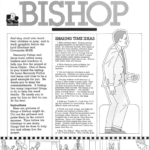[ad_1]
Easter is a wonderful time to dive into scriptures that inspire our deepest hopes, joys, and loves in our faith. Our Easter Sunday celebrations can gain deeper meaning throughout the season when we explore sacred texts that help us understand God’s invitation to new life with God.
Easter can also be the point in the church year when energy around Christian formation wanes. For formation programs that conclude at Pentecost, this seven-week home stretch can be a challenging time for ministry leaders to plan and facilitate an Easter seasonal series.
If you are seeking ideas for an Easter season formation program, this article offers 10 ways to design a seven-week Bible study that connects with Easter readings and themes. These Bible study ideas are aimed at adult formation groups, but some may also be appropriate to use with children, youth, or intergenerational groups. My hope is that these ideas will make it easier for leaders to plan Easter formation and to share more deeply in the joy of the season all the way to Pentecost.
Scriptures Featured in the Lectionary
1. Acts
This book shows up during the Easter season every year in the Revised Common Lectionary (RCL) lessons (see the Reverse Lectionary), so it is a fitting choice for an Easter Bible study. You can tailor your study to the portions of Acts used in the lectionary each week, or you can work through the whole book by reading four chapters a week.
Here are some examples:
Year A-based
- Week 1 | Acts 10:34–43
- Week 2 | Acts 2:14a, 22–32
- Week 3 | Acts 2:14a, 36–41
- Week 4 | Acts 2:42–47
- Week 5 | Acts 7:55–60
- Week 6 | Acts 17:22–31
- Week 7 | Acts 1:6–14
Whole Book
- Week 1 | Acts 1 – 4
- Week 2 | Acts 5 – 8
- Week 3 | Acts 9 – 12
- Week 4 | Acts 13 – 16
- Week 5 | Acts 17 – 20
- Week 6 | Acts 21 – 24
- Week 7 | Acts 25 – 28
2. I John
This letter appears in the RCL New Testament lessons for Year B. Its emphasis on loving one another and its brevity can prompt in-depth reflection on what communal life in Christ means for contemporary Christians.
You might try one of these design options:
Year B-based
- Week 1 | Introduction to I John
- Week 2 | I John 1:1 — 2:2
- Week 3 | I John 3:1–7
- Week 4 | I John 3:16–24
- Week 5 | I John 4:7–21
- Week 6 | I John 5:1–6
- Week 7 | I John 5:9–13
Whole Book
- Week 1 | Introduction to I John
- Week 2 | I John 1
- Week 3 | I John 2
- Week 4 | I John 3
- Week 5 | I John 4
- Week 6 | I John 5
- Week 7 | Conclusions and Takeaways
3. Revelation, or John’s Apocalypse
Portions of Revelation show up in the RCL New Testament lessons for Year C. Although this book can be daunting to take on in a Bible study because of many misunderstandings and misuses of its contents, it also offers some of the most beautiful, hopeful imaginings of new life and new creation. A study of John’s Apocalypse can follow the lectionary lessons only or engage the whole book in roughly three chapters a week.
Here are a couple ways to organize this study:
Year C-based
- Week 1 | Introduction to Revelation
- Week 2 | Revelation 1:4–8
- Week 3 | Revelation 5:11–14
- Week 4 | Revelation 7:9–17
- Week 5 | Revelation 21:1–6
- Week 6 | Revelation 21:10, 22 — 22:5
- Week 7 | Revelation 22:12–14, 16–17, 20–21
Whole Book
- Week 1 | Revelation 1 – 3
- Week 2 | Revelation 4 – 6
- Week 3 | Revelation 7 – 9
- Week 4 | Revelation 10 – 12
- Week 5 | Revelation 13 – 15
- Week 6 | Revelation 16 – 18
- Week 7 | Revelation 19 – 22
Scriptures That Resonate with Easter and Pentecost Themes
4. Genesis
Between celebrating Jesus’s resurrection and our baptism into his new life, Easter is a season of beginnings. It can be a meaningful time, therefore, to dive into the first book of the Bible and reflect on its stories of creation and of God’s covenants. While working through all of Genesis in seven weeks may be a challenge, a Bible study of the first 11 or 25 chapters is feasible for the Easter season.
These options can help you get started:
Creation to Babel
- Week 1 | Genesis 1:1 — 2:4
- Week 2 | Genesis 2:5–25
- Week 3 | Genesis 3 – 4
- Week 4 | Genesis 5 – 6
- Week 5 | Genesis 7 – 8
- Week 6 | Genesis 9 – 10
- Week 7 | Genesis 11
Creation to Abram/Abraham Saga
- Week 1 | Genesis 1 – 3
- Week 2 | Genesis 4 – 6
- Week 3 | Genesis 7 – 10
- Week 4 | Genesis 11 – 14
- Week 5 | Genesis 15 – 18
- Week 6 | Genesis 19 – 22
- Week 7 | Genesis 23 – 25
5. Exodus
Both the exodus story and the Easter drama speak to the liberating activity of God, and this thematic intersection makes Exodus an illuminating book to study in Easter. Focusing on the first 20 chapters in particular, from the start of Israel’s oppression in Egypt to the gift of the Ten Commandments, enables sustained discussion of 2–3 chapters a week.
The schedule can look something like this:
- Week 1 | Exodus 1 – 3
- Week 2 | Exodus 4 – 6
- Week 3 | Exodus 7 – 9
- Week 4 | Exodus 10 – 12
- Week 5 | Exodus 13 – 15
- Week 6 | Exodus 16 – 18
- Week 7 | Exodus 19 – 20
6. Psalms
The Psalter expresses the gamut of human experiences, and its celebratory and thanksgiving psalms are particularly fruitful passages to study during Easter. A helpful resource for selecting psalms on these themes is Walter Brueggemann’s book The Message of the Psalms: A Theological Commentary (Minneapolis: Augsburg, 1984). In the chapter “Psalms of New Orientation,” Brueggemann lists a number of psalms that express thanks and praise to God (pp. 123–167).
Here is one possible study based on some of the psalms he includes:
- Week 1 | Psalm 27
- Week 2 | Psalm 30
- Week 3 | Psalm 65
- Week 4 | Psalm 113
- Week 5 | Psalm 116
- Week 6 | Psalm 147
- Week 7 | Psalm 148
7. Isaiah
Hopeful eschatological visions emerge throughout Isaiah’s prophetic passages. These words of promise can be powerful scriptures to investigate during Easter.
A number of passages from this book can be instructive for an Easter study. Here is one way to proceed:
- Week 1 | Isaiah 2:1–5; 4
- Week 2 | Isaiah 11 – 12
- Week 3 | 25:1–10; 35
- Week 4 | Isaiah 40 – 44
- Week 5 | Isaiah 55
- Week 6 | Isaiah 60 – 62
- Week 7 | Isaiah 65:17–25
Topical Studies
8. Easter Vigil Lessons
For some churches, the first Easter service is The Great Vigil the night before Easter Sunday, which includes reading a series of scriptures “of God’s saving deeds in history” (The Book of Common Prayer, p. 287). These scripture lessons can become a useful Bible study guide for the subsequent season. In addition to the Revised Common Lectionary, another helpful set of resources for developing a study are Wilda Gafney’s A Women’s Lectionary for the Whole Church volumes for Year A and Year W (New York: Church Publishing, 2021, both editions). These books feature Vigil lessons aimed at “centering women’s stories” in scripture, as Gafney says (p. xii).
Here are two examples:
Revised Common Lectionary Lessons
- Week 1 | Genesis 1:1 — 2:4a
- Week 2 | Genesis 7:1–5, 11–18; 8:6–18; 9:8–13
- Week 3 | Exodus 14:10–31; 15:20–21
- Week 4 | Isaiah 55:1–11
- Week 5 | Ezekiel 37:1–14
- Week 6 | Romans 6:3–11
- Week 7 | Matthew 28:1–10
A Women’s Lectionary, Year W Lessons (pp. 133–142)
- Week 1 | “A God-Crafted Creation,” Genesis 1:1–2, 26–27; 2:1–4
- Week 2 | “The Salvation of Hagar and Ishmael,” Genesis 21:2, 8–21
- Week 3 | “From Slavery to Freedom,” Exodus 14:26–29; 15:20–21
- Week 4 | “Rahab’s Salvation,” Joshua 2:1–14; 6:15–17, 22–23
- Week 5 | “Deborah Saves the People,” Judges 4:1–10, 23
- Week 6 | Epistle, Acts 16:13–15
- Week 7 | Gospel, Matthew 28:1–10
9. Creation and New Creation Care
Easter’s theme of new creation offers an opportunity to examine intersections between creation, new creation, and creation care in scripture. An insightful resource for facilitating a Bible study on these topics is Scripture, Culture, and Agriculture: An Agrarian Reading of the Bible by Ellen Davis (New York: Cambridge University Press, 2008). Chapters 3–9 in particular provide helpful commentary on scriptures across the Old and New Testaments that engage care for nonhuman creation.
Here are two ways to structure this study, one using Davis’s book and scripture selections and the other surveying texts on nonhuman creation and new creation:
Using Scripture, Culture, and Agriculture
- Week 1 | Ch. 3 with Genesis 1
- Week 2 | Ch. 4 with Exodus 16
- Week 3 | Ch. 5 with Leviticus 19
- Week 4 | Ch. 6 with I Kings 21 and Psalm 37
- Week 5 | Ch. 7 with Amos 1 – 9 or Hosea 2, 4, and 9
- Week 6 | Ch. 8 with Proverbs 31
- Week 7 | Ch. 9 with Micah 3 and 6 and Song of Songs 8
Survey of Creation and New Creation
- Week 1 | Job 38 – 39
- Week 2 | Isaiah 11
- Week 3 | Isaiah 65:17–25
- Week 4 | Joel 2:15–29
- Week 5 | II Corinthians 5:16–21
- Week 6 | Revelation 21 – 22
- Week 7 | Genesis 1 – 2
10. The Holy Spirit
Because the Easter season concludes with Pentecost, a good topic to study in preparation for this feast is the Holy Spirit. Not only does the Spirit of God show up across the scriptures in intriguing ways, but the Spirit is also instrumental in raising Jesus from death.
A few scriptures to consider are the following:
- Week 1 | Genesis 1 – 2, Creation
- Week 2 | Isaiah 61, Spirit of the Lord and the Year of Favor
- Week 3 | Matthew 3, Jesus’s Baptism
- Week 4 | Acts 2, The Day of Pentecost
- Week 5 | Acts 10, The Spirit Falls on the Gentiles
- Week 6 | Romans 8, Life in Christ through the Spirit
- Week 7 | I Corinthians 12, Gifts of the Spirit
Featured image is by Sixteen Miles Out on Unsplash
[ad_2]
Source link







You must be logged in to post a comment.